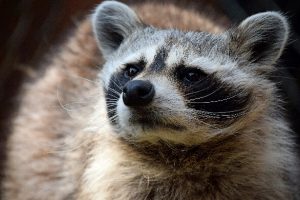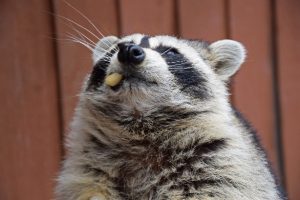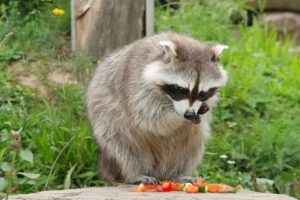

Masks, Mischief, and Misunderstandings: Raccoons and Their Benefits
There may have been a time when you went out into your yard only to see your garbage can sitting on its side with the lid off and contents scattered around. Chances are you had a visit from a raccoon! These “trash pandas” are notorious for being mischievous and getting into things they shouldn’t be. Despite their mischief, raccoons play an important role in their ecosystem. International Raccoon Awareness Day, celebrated on October 1st, is a day dedicated to bringing attention to these often misunderstood animals. So, let’s learn a little about them!
 Raccoons can be found throughout North and Central America, Europe, and even Japan in a variety of ecosystems. They are about the size of a small dog, growing around 2-3ft in length and weighing 10-30lbs. Perhaps their most characteristic and familiar feature is the black fur that covers their eyes, hence the nickname masked bandit. Raccoons are opportunistic omnivores that eat a variety of plant and animal matter. And since they are no strangers to dumpster diving, it’s likely that they will find a way into your garbage can! Although primarily nocturnal, they can be seen during the day looking for food to support their young, taking advantage of a garden while the dogs are inside, or trying to move to a new location to call home.
Raccoons can be found throughout North and Central America, Europe, and even Japan in a variety of ecosystems. They are about the size of a small dog, growing around 2-3ft in length and weighing 10-30lbs. Perhaps their most characteristic and familiar feature is the black fur that covers their eyes, hence the nickname masked bandit. Raccoons are opportunistic omnivores that eat a variety of plant and animal matter. And since they are no strangers to dumpster diving, it’s likely that they will find a way into your garbage can! Although primarily nocturnal, they can be seen during the day looking for food to support their young, taking advantage of a garden while the dogs are inside, or trying to move to a new location to call home.
 As you can imagine, raccoons invading yards and eating trash can often cause conflict with humans. A lot of the time these animals are seen as pests, but did you know that raccoons are extremely beneficial to the ecosystem? Raccoons are part of nature’s “clean-up crew.” They eat just about anything, including carrion (or dead animal carcasses). They’ll eat the remains that most other animals will not touch, which helps to keep our ecosystems clean. Along with being scavengers, raccoons are also good predators. They prey on many pest species, such as rats, wasps, toads, and lizards, and help to keep populations in check. Without animals like raccoons, these pests would run rampant and could cause a lot of damage to gardens, backyards, and even put your health at risk.
As you can imagine, raccoons invading yards and eating trash can often cause conflict with humans. A lot of the time these animals are seen as pests, but did you know that raccoons are extremely beneficial to the ecosystem? Raccoons are part of nature’s “clean-up crew.” They eat just about anything, including carrion (or dead animal carcasses). They’ll eat the remains that most other animals will not touch, which helps to keep our ecosystems clean. Along with being scavengers, raccoons are also good predators. They prey on many pest species, such as rats, wasps, toads, and lizards, and help to keep populations in check. Without animals like raccoons, these pests would run rampant and could cause a lot of damage to gardens, backyards, and even put your health at risk.
 But that’s not all! Raccoons are also excellent seed dispersers. When they eat wild fruits, berries, and nuts, they do not digest the seeds. Those seeds are then deposited in the raccoon’s poop. Since raccoons may travel more than 10 miles in search of food, they can disperse those seeds to new areas allowing for more diversity. Raccoons are also important in the lifecycle of many plants. They are known to be diggers, which may seem like a bad thing, but for plants it’s actually great! They assist in soil turnover, which aerates the soil making it easier for plants to grow and for decomposition to occur faster.
But that’s not all! Raccoons are also excellent seed dispersers. When they eat wild fruits, berries, and nuts, they do not digest the seeds. Those seeds are then deposited in the raccoon’s poop. Since raccoons may travel more than 10 miles in search of food, they can disperse those seeds to new areas allowing for more diversity. Raccoons are also important in the lifecycle of many plants. They are known to be diggers, which may seem like a bad thing, but for plants it’s actually great! They assist in soil turnover, which aerates the soil making it easier for plants to grow and for decomposition to occur faster.
One thing you may not think of is how raccoons serve as prey for other animals. While they are great at catching their food, raccoons aren’t very high on the food chain. They make a great meal for many larger carnivores, like coyotes and foxes, as well as great horned owls. Just like how raccoons help control the population of smaller pest species, these predators help control the raccoon population.
Hopefully you’ve learned a little bit more about these curious (and at times mischievous) animals and have a newfound appreciation for all raccoons can do for us. If we work together, we can clear up some of the misconceptions surrounding raccoons and work towards a world where we can coexist peacefully. Education is one of the first steps in doing this, so thanks for reading!
Written by Emily Granville
Education Specialist
Lehigh Valley Zoo | Schnecksville, PA